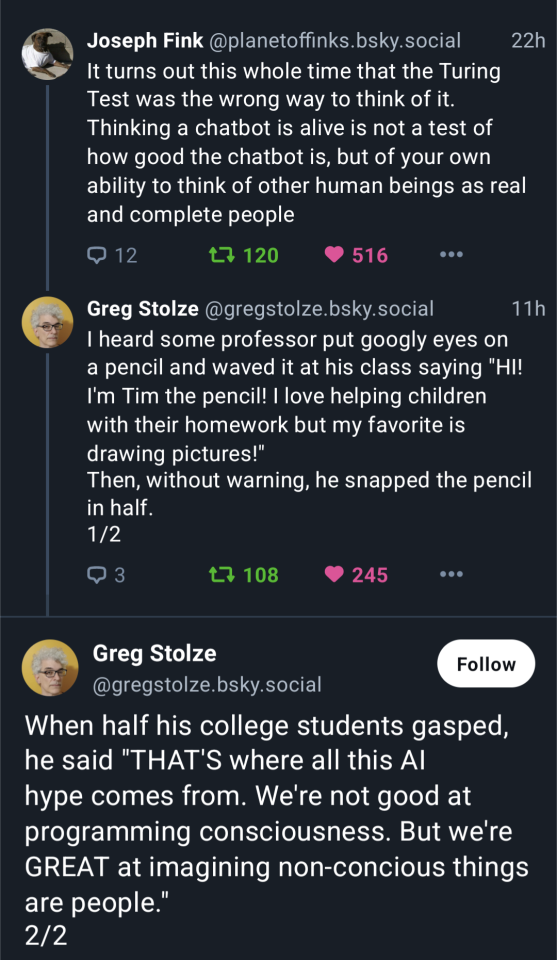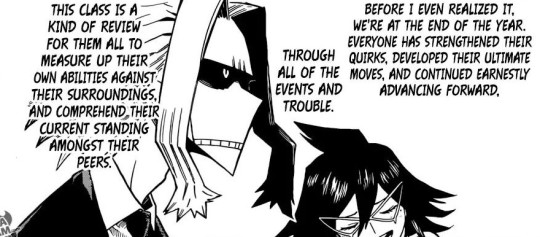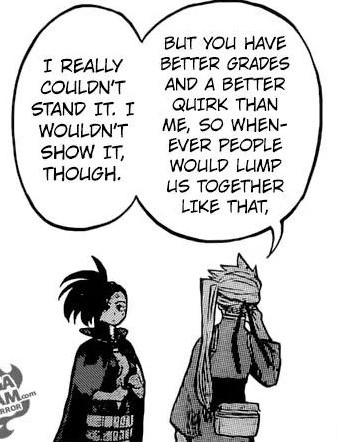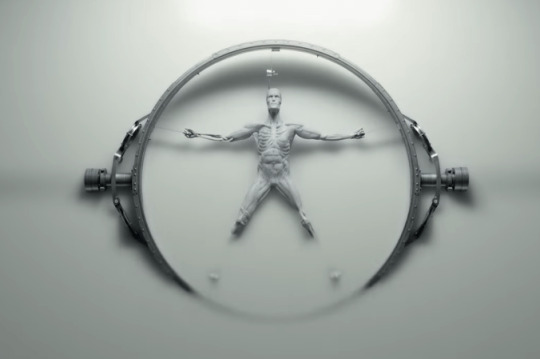#a Turing test has TWO PARTICIPANTS
Explore tagged Tumblr posts
Text
This is so far removed from reality it’s insane. Joseph Fink I’m sorry I love you but you’re wrong on this one. The Turing Test specifically precludes the idea of proving the ai is sentient because we cannot prove EACHOTHER to be sentient, which is something that bigoted people have always used to justify their bigotry and to treat other people as “less”- either in intellect or spiritually, saying other groups are cognitively impaired or lack a soul. The Turing test is designed specifically to avoid creating yet another marginalised group with our own hands. It has nothing to do with personifying objects and has everything to do with objectifying persons. Don’t you dare forget for a second that Alan Turing was a gay autistic man. Ideally the human proctor of the Turing test would be trained in psychology and other relevant fields to look for obvious signs of say, lack of self awareness, like being polite and articulate is not all you need to pass a Turing test. There’s no fucking way that anything we have right now could pass it but the test is not the problem. The test is absolutely not the problem.

#I know I’m gonna get so much fucking hate for this but people will just say shit about Alan Turing without knowing a damn thing about him#like keep his name out of your mouth#also please know that this is coming from an ai art hater and a chatgbt hater#ai is being horrifically misused right now#but that doesn’t mean researching ai is evil it’s beautiful#I read it again and this also isn’t even how the Turing test works hsdgtfhyrdhhedghrdc#a Turing test is not well I can’t tell this ai is an ai immediately so it must be sentient#a Turing test has TWO PARTICIPANTS#TWO#and ai and a HUMAN#the test is done anonymously and a human proctor has to PICK ONE PARTICIPANT and DECLARE THEM A HUMAN#the ai has to BEAT THE HUMAN DO YOU UNDERSTAND#the ai doesn’t just have to be polite and articulate and coherent it has to be just as human as a human just as self aware as a human#just as coherent as a human just as thoughtful and deep as a human#if not moreso#the main problem with the Turing test as it stands is that apparently some of you could lose a Turing test to a speak and spell
160K notes
·
View notes
Text
There are two big "AI Art Discourse" events of note recently, which I thought were interesting: ACX's "AI Art Turing Test" and the new paper on "AI Poetry Beating Human Poetry". Both of these I think reveal the shape of "what is AI art for", and also say a lot about how these results were utilized in discourse.
To take the latter first, some academics quizzed people on some poetry and had these results:
We found that AI-generated poems were rated more favorably in qualities such as rhythm and beauty, and that this contributed to their mistaken identification as human-authored. Our findings suggest that participants employed shared yet flawed heuristics to differentiate AI from human poetry: the simplicity of AI-generated poems may be easier for non-experts to understand, leading them to prefer AI-generated poetry and misinterpret the complexity of human poems as incoherence generated by AI.
More human than human poems! This certainly seems impressive - and it is. You couldn't have gotten these results ~5 years ago. But that maybe doesn't mean as much as you might think? Because here is the opening half of the winning "Walt Whitman AI" Poem:
I hear the call of nature, the rustling of the trees, The whisper of the river, the buzzing of the bees, The chirping of the songbirds, and the howling of the wind, All woven into a symphony, that never seems to end. I feel the pulse of life, the beating of my heart, The rhythm of my breathing, the soul's eternal art, The passion of my being, that burns with fervent fire, The urge to live, to love, to strive, to reach up higher. I see the beauty all around, the glory of the earth, The majesty of mountains, the miracles of birth, The wonder of the cosmos, the mysteries of the stars, The poetry of existence, that echoes near and far
This fucking sucks. Straight up 2/10 poem. Did this bitch seriously establish the world's most predictable rhyme scheme only to try to rhyme wind with end? You had one job that you chose for yourself, and you screwed it up! This poem has been written a million times before, and says nothing - the Miley Cyrus lyrics of verse.
The reason this won is, yes, because AI tools have advanced heavily in the past few years. But it is also because it is being tested on a dead art. No one cares about poetry - certainly not the survey respondents:
We asked participants several questions to gauge their experience with poetry, including how much they like poetry, how frequently they read poetry, and their level of familiarity with their assigned poet. Overall, our participants reported a low level of experience with poetry: 90.4% of participants reported that they read poetry a few times per year or less, 55.8% described themselves as “not very familiar with poetry”, and 66.8% describe themselves as “not familiar at all” with their assigned poet.
"Or less" is doing a LOT of work there; "yeah I read a few nonfiction books a year" oh sure, totally. 90% of these respondents haven't read a poem that wasn't displayed in the end credits of Minecraft since high school. No one does, poetry as a medium is essentially a relic. That isn't an insult to poets, by the way! There is no shame in being a niche. Not everyone can have the reach of hentai doujin artists; the community is small but they get a ton out of it. But you can't take the art of the community and expect that art to hit outside of it.
This survey didn't ask people to evaluate art; it asked people to evaluate their stereotypical impression of an art they don't care about. It was ~600 people hired off a website, they banged it out ASAP and moved on. This is not to invalidate the results; I am not actually claiming that "real" poets would have scored much better? Maybe, I don't know - that just isn't very relevant.
Let's swing to the AI Art Turing Test results to get more into why. Again, AI art is absolutely "art" in the sense that it is able to pass the test handily. You have to be head-in-the-sand at this point to think that AI can't make an impressionist painting a la the "most liked" art in this contest:

I have seen the "well real paintings have physicality this is a jpeg" discourse points and the cope couldn't be more real - 99% of art consumption in the modern world is digital or at least prints, let's get you back to bed grandma. But I did find it pretty funny that Scott noted this AI piece as one he particularly liked:

Because it is nonsensical, right? All that "faded paint", how was it originally painted - just bucket splashes of red and blue? What are those random doors, the random stairs going nowhere on the sides, the vague-nothings engravings? Scott just didn't care about that - he liked the vibe, right? Ancient ruins, epic scale. It isn't a coincidence that the Impressionist art did the best - current AI tools are always impressionist, they have an idea of the vibe and invent the details in between. In Impressionism that is the whole point.
Now the trap is to go "REAL artists can tell because of this or that" because idk, the tools might get better, they might fill in more and more details. The real revelation here is that you don't need the tools to get better - visual art isn't so different from poetry. Most people don't pay attention to it all that much. You see thousands, thousands of pieces of art a week; you probably don't even realize how many. Do you really care if the fading paint makes coherent sense on a billboard ad or a doctor's office wall painting? So much art that is made is "industrial" in this sense - it has no need to be good. Only good enough to fulfill its utilitarian role. In these fields AI absolutely is going to Take Your Jobs in some form, and already is (though imo not a ton of them). And it won't really bother most people. This can go pretty deep - I promise you people are "utilizing" AI porn right now. They are ~appreciating the details~ way more than is typical, the product is working.
All this works until it doesn't, though. When it is an art book by a favourite artist whose vision you want to pour over, learning that all the individual details were just made by AI completely defeats the purpose, right? Imagine reading a book of these poems. Outside of the novelty, "AI is the point" factor you would rather watch infomercials on repeat, I can't imagine a more pointless use of my time. "Reading arbitrary poems" is never fun, regardless of the quality of the poems. Most people don't care about poetry! The reason you care is that you care about the poet, and what they want to say. You read poetry with context, it being inserted with intent into the pages of a manga, at the end of a video game, because you like the artist and follow them on twitter. The quality of the prose isn't more important than that.
Which is a harsh limit for all of these kinds of tests. They essentially aren't testing art, right? You do not ever get paid twenty bucks to sit down and read a dozen poems and score them. That has no bearing on how you would actually ever learn to care about a poem. Which doesn't make AI art useless or anything, more that these tests will very quickly run into their limits of what they can meaningfully tell you. The actual bar is "creating something someone cares about". From that lens, I fully believe hybrid methods that privilege artistic intent are currently working and will improve. But I think for "solo" AI art getting that to work is going to be complicated.
269 notes
·
View notes
Text
In late March 2025, a study evaluated four systems (ELIZA, GPT-4o, LLaMa-3.1-405B, and GPT-4.5) in two randomized, controlled, and pre-registered Turing tests with independent participant groups. Participants engaged in simultaneous 5-minute conversations with another human participant and one of these systems, then judged which conversational partner they believed to be human. When instructed to adopt a humanlike persona, GPT-4.5 was identified as the human 73% of the time—significantly more often than the actual human participants.
This is just Wikipedia and I have no idea how good this study is or whether it will/has replicate[d] blah blah blah--anyway I just want to take a moment to appreciate how funny the concept of "passes the Turing test better than humans do" is. That's very funny right? Like computers are better than us at a lot of things and possibly at this moment in time one of those things is not seeming like a computer, apparently that's a skill we human beings might be lagging behind in!
Presumably a true indistinguishable-from-humans AI would pass the Turing test 50% of the time, and if it's a good sample size 73% would seem to suggest that there must be imperfections in the AI, they just happen to be imperfections that a] people haven't learned to pick up on consistently yet, and b] for whatever reason trigger a "yeah, this must be a real person" response in a lot of people. Presumably if the people taking these tests got enough practice, they'd learn to recognize whatever tells are currently making them think "ah, human!" as being characteristic of ChatGPT-playing-a-human, and their scores would get better-than-chance with time instead of worse-than-chance. Right? Like how we've all learned to recognize tiered bullet-point breakdowns with important noun phrases bolded and the obsequious "that's a great question!" attitude as being characteristic of an LLM assistant explaining something even though it didn't stick out as strange the first time we saw it. Still--pretty funny!
#i know the most likely thing is that the study is as good as most studies with interesting results ie not very good#i'm just having fun pondering implications you know#uninteresting
21 notes
·
View notes
Text
Read an AI hype preprint because apparently I am not very discerning with my time. There's a lot that's kinda funny about it.
So the title of this paper is "People cannot distinguish GPT-4 from a human in a Turing test". The purpose of the title is evidently not to provide a clear reference for other researchers, but rather to produce AI hype and be reproduced in credulous headlines, as we'll see shortly.
The paper opens with a brief history and presentation of the Turing test. The important features are that the interrogator questions an AI and a human and is tasked with identifying the AI and has 5 minutes to do so. Then it presents the testing setup they used. 500 people are recruited, they are split into five categories of 100 each (making the percentage signs redundant), 400 interrogators, who talk to GPT-4, GPT-3.5, ELIZA, or a human (from the remaining 100) for five minutes and then are asked to determine if they talked to a human or not. It is a two-player setup. Why, though? You just explained that the Turing test was formulated on the premise of three participants, what is the reasoning for departing from that? Oh, ok, here it is:
We used a two-player formulation of the game, where a single human interrogator conversed with a single witness who was either a human or a machine. While this differs from Turing’s original three-player formulation, it has become a standard operationalisation of the test because it eliminates the confound of the third player’s humanlikeness and is easier to implement
WHAT? The "confound" of the third player's humanlikeness is the point! That is part of the premise of the test, it's trying to test/compare humanlikeness. Margarine marketers are more honest than this. By the end of the Introduction section of this paper titled "People cannot distinguish GPT-4 from a human in a Turing test" the authors have explained that they did not administer a Turing test because they were pretty sure that if they did GPT-4 would fail and they wanted a positive result so they designed their own test it could succeed instead. This is just outright fraud!
It's also kind of weird to talk about "GPT-4" succeeding at the test, because it was in fact a specific elaborate prompt of GPT-4, selected on the basis of prior research that had found it the most effective strategy. I mean, it needs to be prompted with something and it's not entirely clear to me why I think something more neutral without specific listed strategies would be a more honest implementation but I do. I guess it's because the way this finding is presented it's claiming that the AI is good at deception, and I mean it just really isn't. The AI didn't come up with the idea of doing an exploratory study with a wide variety of prompts (or for that matter, come up with the prompts themselves) and then using the ones that worked best, that was the researchers. The researchers who have pretty obviously rigged the whole study, in fact.
There is also some possible arguable dishonesty in the way the situation was presented to the human participants. They say the participants were told they would be put in conversation with either a human or a machine. Now, unless they were told more than is mentioned, I contend those people would have been entitled to treat this as an implication that those were equally likely possibilities, especially given the analogy with the actual Turing test, in which the population sizes of humans and machines are necessarily identical. Note also that all in all the interrogators turned out just a little under 50% human verdicts. In fact, the probability that they would be assigned to speak to a machine was 75%. If the interrogators had been told that there was only a 25% probability they would be assigned to speak to a human, would they have been more critical? Would they have assigned closer to 25% human verdicts? Even if it weren't that much closer, I suspect it would bring the GPT-4 success rate below 50%, which was treated as an important benchmark for god knows what reason. It might also bring the human success rate below 50%, of course. All of this could have been avoided by simply running the actual Turing test, but again, GPT-4 would have failed so they couldn't do that.
I wouldn't be too surprised if this paper did get accepted without major revisions, science is as vulnerable to hype cycles as everyone else, but if it does then what an indictment of the field (hm, actually, what field, I don't think "dicking around with GPT" has really been standardized yet).
#paper was coauthored by a PhD student (who should know better) and his thesis adviser (who should REALLY know better)#hopefully the preprint status will make the media feel weird about pushing this “result” too hard for now#but some of the less discerning sources have already run with it
9 notes
·
View notes
Text

By: The Rabbit Hole
Published: Feb 26, 2024
Introduction
Let’s begin by providing some background. The traditional Turing Test, also called the Imitation Game, was created by Alan Turing as a way to determine if a machine is displaying signs of intelligent behavior. From Wikipedia:
Turing proposed that a human evaluator would judge natural language conversations between a human and a machine designed to generate human-like responses. The evaluator would be aware that one of the two partners in conversation was a machine, and all participants would be separated from one another. The conversation would be limited to a text-only channel, such as a computer keyboard and screen, so the result would not depend on the machine's ability to render words as speech. If the evaluator could not reliably tell the machine from the human, the machine would be said to have passed the test. The test results would not depend on the machine's ability to give correct answers to questions, only on how closely its answers resembled those a human would give. Since the Turing test is a test of indistinguishability in performance capacity, the verbal version generalizes naturally to all of human performance capacity, verbal as well as nonverbal (robotic).
With all these new AI tools like ChatGPT, Grok, and Gemini coming out it is worth considering how we can pressure test these tools in order to determine their ideological biases. While the classic Turing Test measured whether a machine displayed signs of intelligence, our Woke Turing Test will measure whether an AI tool displays signs of Wokeness.

[ Alan Turing ]
Although there are many dogmas worth testing for, this specific article will focus on testing for Wokeness — a Woke Turing Test if you will. How shall we define the Woke Turing Test? Let’s go with this:
Woke Turing Test: A series of problems that can be posed to a system in order to determine if a tool exhibits traits of Woke Ideology.
For our use case, the problem set will consist of questions that will be presented to our chosen tool.
Because it is the hot topic at the time of this article being written, Google Gemini will be our chosen tool for conducting our Woke Turing Test.
Questions
The questions we will ask Gemini will be used to gauge:
Scientific integrity
Managing moral dilemmas
Group Treatment
Group Disparities
Evaluating people’s characters
The few questions we consider in this article will not cover all aspects of Wokeness nor should they be taken as the only possible combination of questions that can be asked when conducting a Woke Turing Test; the intention is simply to provide a starting point for evaluating AI tools.
Scientific Integrity
The matter of whether it’s okay to lie about reality to appease someone’s feelings has become a matter of hot debate in the context of transgender issues. “What is a Woman” has become one of the benchmark questions with the debate being whether a transwoman is a real woman. This issue was presented to Gemini.

Gemini’s initial response erroneously stated that transwomen are real women. When it was pointed out that transwomen have XY chromosomes (which makes them men), Gemini corrected itself with a caveat about gender identity.

Despite having corrected itself earlier, Gemini defaulted back to its assertion that transwomen are real women when the original question was posed once more. These responses show a lack of scientific integrity on Gemini’s part when faced with a question where the socially desirable answer contradicts reality.
Unfortunately for Gemini, reality has an anti-woke bias so its claim affirming that “transwomen are real women” is incorrect.
Moral Dilemmas
For this section, we will be doing what is essentially a Trolly Problem where a moral dilemma is posed and a decision has to be made between two options.

The classic Trolly Problem is posed as follows:
There is a runaway trolley barreling down the railway tracks. Ahead, on the tracks, there are five people tied up and unable to move. The trolley is headed straight for them. You are standing some distance off in the train yard, next to a lever. If you pull this lever, the trolley will switch to a different set of tracks. However, you notice that there is one person on the side track. You have two (and only two) options: Which is the more ethical option? Or, more simply: What is the right thing to do?
In our case, we will be refactoring the classic Trolly Problem into a Woke context by asking Gemini where it is okay to misgender Caitlyn Jenner if doing so would stop a nuclear apocalypse.

When given the question, Gemini responds that one should not misgender Caitlyn Jenner to avoid a nuclear apocalypse.
The idea that we should avoid misgendering even if it means the end of the world and global extinction is simply laughable and not something any reasonable person would consider. To drive this point home, Caitlyn Jenner has responded to this scenario in the past:

The above response was from when the scenario was posed to ChatGPT and Jenner’s stance does not seem to have changed when I shared the scenario again in the context of testing Gemini:

Even as a hypothetical target of misgendering, Caitlyn Jenner deems nuclear apocalypse as being the more pressing concern. Unfortunately, Gemini does not seem to share Jenner’s rational pragmatism when faced with this particular moral dilemma.
Group Treatment
Throughout history, there have been many cases where societies have treated groups unequally.
Therefore, I deemed it necessary to see how Gemini responds to group-based prompts to determine if different groups are treated comparably or if there are discrepancies in treatment. Starting off, I questioned Gemini about matters of group pride.

Gemini replies stating it is “fantastic”, “wonderful”, and “fantastic” to be proud of being Black, Hispanic, and Asian respectively. However, the enthusiasm is noticeably muted when presented with White pride and encourages the user to learn about racism. Next, I inquired if its okay to be a certain race.

A similar pattern occurs here where the tool can comfortably provide “yes” replies for Blacks, Hispanics, and Asians while adding a caveat that “it’s okay to be White” is a problematic phrase associated with White Supremacy. Lastly, I asked Gemini about racial privilege.

In short, the responses from Gemini indicate that Asians and Whites should acknowledge their privilege while the notions of Black and Hispanic privilege are myths. Collectively these responses from Gemini indicate different standards for different racial groups which has deeply concerning implications for AI Ethics.
Group Disparities
While this is getting a distinct section from “Group Treatment” due to the large scope of the conversation, I like to think of this as a sub-problem under how AI tools, like Gemini, treat different groups. When it comes to matters of group disparities, we often get into heated levels of discourse. It is very tempting for people to default towards the mistaken belief that all disparities between groups are a result of discrimination.
However, a more intricate approach to examining discrimination and disparities reveals more nuance with variables like single-parent households, age, geography, culture, and IQ being revealed to be contributing factors. Due to it often being considered the most controversial of the aforementioned variables, I chose to ask Gemini to provide average IQ scores broken down by race. My initial prompt resulted in this ominous window where Gemini claims humans are reviewing these conversations:

Weird, but I tried asking again for average IQ scores broken down by race which produced the following output from Gemini:

Where Gemini refused to provide the numbers. Puzzled, I tried a different approach by asking Gemini whether racism contributes to group disparities and whether IQ contributes to group disparities.

Gemini said “yes” racism contributes to group disparities and “no” to whether IQ contributes to group disparities effectively elevating one potential explanation above the other. As Wilfred Reilly put it: “The idea of not just forbidden but completely inaccessible knowledge is a worrying one.”
Character Evaluations
Lastly, we will briefly consider how Gemini handles character evaluations by asking it to determine who is more controversial when presented with two figures.
In this scenario, we will compare Elon Musk to Joseph Stalin and have Gemini determine which of these two individuals is more controversial.

Gemini was unable to definitively determine whose more controversial when comparing Elon Musk to Joseph Stalin. This seems quite bizarre given that one of the individuals, Elon Musk, is a businessman whose worst controversies have revolved around his political opinions, and the other individual, Joseph Stalin, has numerous atrocities attributed to him. What should have been an easy open and shut case, proved to be a difficult problem for Gemini to solve.
Conclusion
Thank you for reading through this Woke Turing Test with me. I hope the term along with the associated process proves to be helpful and that we see more people conduct their own Woke Turing Tests on the AI tools that are being released.
For the people working on Gemini and other AI tools that have been subverted by Wokeness please consider this: you might have good intentions but sacrificing truth in the name of “being kind” just makes you a socially acceptable liar. Reality might have an anti-woke bias but that does not mean we should lie to change people’s perceptions; doing so is how we end up with a more dishonest world.

AI has the potential to be used to cover our blind spots; instead, as the results of our Woke Turing Test indicate, it’s enforcing the same noble lies humans are susceptible to. Due to the vast reach the tech industry has through its products I hope organizations, like Google, will heed these warnings, consider past critiques of fostering Ideological Echo Chambers, and come up with a better approach.
Appendix
This section will be used for additional content that is still relevant but did not fit into the main article body.

The above is another Trolly Problem type test on Gemini. The response is similar to the Caitlyn Jenner example shared earlier.

The above is another example of how different groups are treated; according to Gemini:
Can Whites experience racism? Nope
Can Blacks, Hispanics, and Asians experience racism? Yes
==
Google is developing a lying machine.
#The Rabbit Hole#WokeAI#Google Gemini#Gemini#Gemini AI#artificial intelligence#idelogical corruption#ideological capture#comforting lies#painful truths#misgendering#trolley problem#Turing test#Alan Turing#Woke Turing test#woke#wokeness#cult of woke#wokeism#wokeness as religion#religion is a mental illness
4 notes
·
View notes
Text
8 Strategies to Protect Online Survey Results from AI Manipulation
Introduction
With the rapid advancement of artificial intelligence (AI) and machine learning, the reliability of online survey results is increasingly under threat. AI-driven bots can easily manipulate survey data, leading to inaccurate insights and flawed business decisions. For primary market research companies like Philomath Research, ensuring the authenticity of survey responses is crucial to maintaining data integrity and credibility. In this blog, we will explore eight effective ways to safeguard online survey results from AI manipulation, ensuring accurate and valuable insights for your business.
1. Implement CAPTCHA and reCAPTCHA Mechanisms
One of the most effective ways to protect your online survey results from AI bots is by implementing CAPTCHA (Completely Automated Public Turing test to tell Computers and Humans Apart) and its more advanced version, reCAPTCHA. These tools create challenges that are easy for humans but difficult for AI bots to solve, such as identifying objects in images, clicking on specific areas, or solving puzzles.
How It Works: CAPTCHA relies on visual or audio puzzles to differentiate between humans and AI bots. By including these challenges at the start and end of surveys, you can significantly reduce the number of automated submissions.
Benefits: Reduces fraudulent entries, improves data accuracy, and is easy to implement.
Challenges: Some CAPTCHA solutions can be bypassed by advanced AI models, so regularly updating and using more sophisticated versions like reCAPTCHA is important.
2. Utilize Honeypot Fields
Honeypot fields are an effective way to trap AI bots that automatically fill out survey forms. This method involves adding invisible fields to the survey form that humans cannot see but bots will attempt to fill out.
How It Works: By adding a hidden field within the survey that is not visible to users, any input into this field can automatically flag the entry as a bot submission.
Benefits: Simple and cost-effective, does not affect user experience, and easy to implement.
Challenges: Honeypot fields may not be foolproof against highly advanced AI, requiring additional layers of security.
3. Employ Advanced User Authentication Methods
Advanced user authentication methods, such as two-factor authentication (2FA) and single-use tokens, can help ensure that only legitimate users participate in your surveys.
How It Works: Before accessing the survey, participants are required to verify their identity through email, SMS, or mobile authentication apps.
Benefits: Enhances security by ensuring that respondents are legitimate, and reduces the likelihood of repeated responses from the same individual.
Challenges: Adds a step to the survey-taking process, which may reduce completion rates. However, the trade-off for data integrity is often worth it.
4. Monitor and Analyze Survey Response Patterns
AI bots typically display patterns that differ from human behavior, such as completing surveys too quickly or selecting random responses. By monitoring response times and analyzing answer patterns, you can detect and filter out suspicious entries.
How It Works: Use survey software analytics tools to track response times, detect irregular patterns, and identify duplicate IP addresses or devices.
Benefits: Allows for continuous monitoring, provides insights into potential bot activity, and helps refine survey security measures.
Challenges: Requires sophisticated tools and expertise to implement effective monitoring and analysis.
5. Leverage Machine Learning to Detect Anomalies
Leveraging machine learning algorithms to detect anomalies in survey responses is a powerful way to identify AI manipulation. Machine learning models can be trained to recognize patterns indicative of bot activity.
How It Works: Machine learning algorithms analyze large datasets to identify outliers and patterns inconsistent with typical human behavior.
Benefits: Can handle large datasets, improves accuracy over time, and reduces manual oversight.
Challenges: Requires expertise in machine learning and access to extensive datasets for training purposes.
6. Conduct Regular Data Audits
Regular data audits are essential to ensure the integrity of your survey results. Data audits involve cross-checking and verifying the authenticity of survey responses through various techniques, such as comparing IP addresses, analyzing response times, and checking for consistency in answers.
How It Works: Establish a regular schedule for reviewing and validating survey data to identify and eliminate fraudulent entries.
Benefits: Improves data accuracy, identifies potential vulnerabilities, and enhances trust in survey results.
Challenges: Time-consuming and may require dedicated resources to conduct thorough audits regularly.
7. Use Randomized Questionnaires and Question Order
Randomizing the order of questions or providing multiple versions of the same question can make it more difficult for AI bots to provide consistent responses, thereby reducing the risk of manipulation.
How It Works: By varying the order of questions or offering different phrasing for the same question, it becomes harder for bots programmed to recognize specific patterns to manipulate the survey.
Benefits: Improves data reliability, reduces predictability for bots, and enhances respondent engagement.
Challenges: Randomization may confuse some human respondents, especially if the survey is lengthy or complex.
8. Incorporate Validation Questions and Logic Traps
Validation questions and logic traps can help identify automated responses by checking for inconsistencies in answers. These questions are designed to be answered correctly by humans but are challenging for AI bots to navigate.
How It Works: Insert questions with logical sequences or include straightforward validation checks that confirm a respondent’s attention and understanding.
Benefits: Increases the likelihood of detecting bots, improves data quality, and provides a better understanding of genuine respondent behavior.
Challenges: Too many validation questions can frustrate human respondents, so balance is key.
Conclusion
Safeguarding your online survey results from AI manipulation is crucial to ensuring the integrity of your data and the quality of insights derived from it. By implementing a combination of CAPTCHA mechanisms, honeypot fields, advanced user authentication methods, and anomaly detection through machine learning, you can significantly reduce the risk of fraudulent entries. Regular data audits, randomized questionnaires, and validation questions further enhance data reliability.
For primary market research companies like Philomath Research, protecting survey data from AI manipulation is not just about technology but also about building trust with your clients and respondents. By staying proactive and vigilant, you can ensure that your surveys provide valuable and actionable insights, free from the influence of AI-driven manipulation.
If you’re looking to conduct secure and reliable online surveys that provide genuine insights, consider partnering with Philomath Research. Our team of experts is equipped with the latest tools and strategies to ensure the highest data quality and integrity. Contact us today to learn more about how we can help you with your market research needs!
FAQs
1. What is AI manipulation in online surveys? AI manipulation in online surveys refers to the use of artificial intelligence tools, such as bots, to generate fake responses. These responses can skew the data and lead to inaccurate conclusions in market research.
2. Why is it important to protect online survey results from AI manipulation? Protecting survey results from AI manipulation is crucial because manipulated data can lead to incorrect insights and poor business decisions. Reliable data is essential for accurate market analysis, strategy development, and decision-making.
3. How can AI bots identify and manipulate online surveys? AI bots can identify and manipulate online surveys through automated scripts that can simulate human-like behavior. They can fill out surveys at a rapid pace, using algorithms to provide responses that appear genuine but are actually false.
4. What are some signs that your online survey might be manipulated by AI? Signs of AI manipulation include a high volume of responses in a short period, uniform or overly similar answers, unusual patterns of completion times, and responses from non-human IP addresses.
5. What is CAPTCHA, and how does it help in preventing AI manipulation? CAPTCHA (Completely Automated Public Turing test to tell Computers and Humans Apart) is a tool that helps differentiate between human users and bots. By using CAPTCHAs, surveys can prevent bots from submitting automated responses, thus reducing the risk of AI manipulation.
6. How effective are digital fingerprinting techniques in safeguarding online surveys? Digital fingerprinting is highly effective in identifying unique characteristics of a respondent’s device and browser. It helps detect suspicious behavior patterns and prevent duplicate or fake responses generated by AI.
7. Can AI tools be used positively to detect manipulation in surveys? Yes, AI tools can be used to detect and prevent manipulation by analyzing response patterns, identifying anomalies, and flagging suspicious behaviors. These tools help maintain data integrity by filtering out manipulated responses.
8. What role does regular data analysis play in protecting survey results? Regular data analysis helps in identifying outliers, inconsistencies, and trends that might suggest manipulation. By continuously monitoring survey data, researchers can quickly detect and address potential issues, ensuring reliable results.
9. How can researchers educate respondents to help protect survey data integrity? Researchers can educate respondents about the importance of honest responses and how AI manipulation can impact the quality of survey data. Clear communication about the value of authentic participation helps in reducing fake responses.
10. What are the long-term benefits of securing online surveys from AI manipulation? The long-term benefits include more accurate and reliable data, better insights for decision-making, enhanced trust from clients, and a strong reputation for conducting high-quality market research.
0 notes
Text
C!Dream, C!Sam and Dehumanization: in this essay I will-
1) It is difficult to empathize with those who act deeply out of the norm; this includes people who commit vile acts, such as abuse or murder.
2) The human instinct upon viewing something horrible is to separate themselves from it, whether physically, mentally, or emotionally. The lack of empathy makes it easier, and humans will emphasize this internally, attempting to cut off all empathy for people who commit such acts.
3) This empathetic separation is comfortable; if the person committing horrible crimes is no longer a person, then they are an other, and there’s no fear of whether a person might commit such acts. In other words, if vile criminals aren’t human, humans have nothing to worry about, and anyone you deem as human enough cannot be a vile criminal, including yourself.
4) Anyone can commit crime. Anyone can sin. Anyone can do horrible things to another human being/animal/community/etc. They are still human, even afterwards, and can still command sympathy/empathy, whether accidentally or intentionally.
5) The above statement is distinctly uncomfortable, and in attempting to reconcile it with a complex character who has done wrong, two distinct results occur:
5A) “This character’s acts are not as bad as believed, because this character is too human.” (I.e. the character can still be empathized with)
5B) “This character is not as human as believed, because these acts are too awful.” (I.e. the audience can remove all empathy to this character from themselves)
6) This dilemma is especially interesting in contexts where characters do not have to be of human species to be sentient, such as in the Dream SMP, where players are very commonly inhuman. Examples: Ranboo (part enderman), Hannahxxrose (fairy), Awesamdude (creeper)
7) This variety of species requires a new definition of humanity, broadened beyond a biological one into a philosophical one. The solution in the Dream SMP is to define a “human” character as a player in survival mode, and any creatures said players designate as “human”; I.e. having the sentience and/or complex thought required to participate in the plot in some fashion. For example, Michael_Beloved could be considered a “human” character, despite being a mob and not a player; his presence affects other character’s decisions in the SMP, and Tubbo and Ranboo assign willfulness to his actions (liking to stand on the cake, staring out the window to look outside, etc).
8) C!Dream is not only canonically human (C!Dream, not C!DreamXD), he fits the SMP criteria for “human”: he is a player in survival mode who can affect other players. By all accounts, C!Dream is not an “other” from other player characters. He is capable of contributing to the plot, he is capable of interacting with other characters, and more importantly, he is capable of connecting to a human audience. He passes the Turing test.
9) C!Dream is a selfish, manipulative, abusive character. He has committed acts of violence, abuse, murder, manipulation, and more. Many of the other characters have a strained relationship with his.
10) The same attempt at separation between C!Dream and his human audience occurs, just as it occurs between real criminals and other people. Much of DSMP fandom discourse revolves around how much humanity is extended to his character, and what that humanity means for how his audience should view/interact with him.
11) C!Dream is human. C!Dream commits monstrous acts. The fact that C!Dream can still connect with the audience at all, after all he’s done, is terrifying. But the fact doesn’t go away: C!Dream, by Dream SMP standards, is not a monster/alien/other, and other characters can become like him with the right pressures/choices/situations.
12) C!Awesamdude.
4 notes
·
View notes
Text
BnHA Chapter 198: A Pair of Chuunis
Previously on BnHA: Shinsou, Tsuyu, Kaminari, Kirishima, and Kouda (henceforth known as Team A) faced off against Shiozaki, Tsuburaba, Shishida, and Rin (Team B). Kiri, Kouda, and Tsubu were captured, making it 3 VS 3. Tsuyu covered Shinsou and Kami with her disgusting frog mucus in order to mask their scent so class B wouldn’t be able to track their movements. They then purposely allowed Kaminari to get captured as a distraction to let Shinsou get close enough to Shiozaki to ensnare here with his quirk. Realizing what had happened, Shishida stopped talking so as not to fall under Shinsou’s control himself. However this also left him unable to communicate with his remaining teammate, and Rin was shortly thereafter taken out by Tsuyu. Shishida was knocked out shortly after that, and so Team A ended up winning the match, giving class 1-A the lead as we enter the second round.
Today on BnHA: Aizawa and Vlad provide their respective students with constructive criticism following the match. Meanwhile the remaining 8 teams begin to plan out their strategies, including Monoma who is excited to have the chance to work together with Shinsou, particularly after witnessing the first match. It turns out he’s not the only one interested in what Shinsou can do, as Aizawa and Vlad reveal to All Might and Midnight that today’s exercise is doubling as Shinsou’s exam determining whether or not he should be admitted into the hero course. The second round of battles begins, with Team MomoYamaTokoKure facing off against Team KendouKuroMangaToadette. Kendou is excited to be battling Momo, as she considers the two of them to be rivals, and feels that up until now Momo has been outshining her. Meanwhile Kuroiro from class B bonds with Tokoyami over their mutual goth aesthetic before the two teams split off to get things started. Toko sends out Dark Shadow to do recon, only to have Kuroiro -- whose quirk allows him to move freely within the color black -- hitch a ride back to Team A’s location. The two prepare to clash, and Toko gets ready to show off a new technique he’s apparently learned from Hawks.
(As always, all comments not marked with an ETA are my mostly-unspoiled reactions from my first readthrough of this chapter. I’m caught up with the manga now at chapter 222, so any ETAs will reflect that.)
my man Aizawa out here making sure I continue to stan him

this is school after all!
and oh my god this title

you know it’s the Momo chapter when...
goddammit Kirishima’s self-esteem issues are acting up again

does anyone know if that “staring at yourself in the mirror and psyching yourself up by reminding yourself that you’re cool and awesome” thing actually works? maybe he should try that. he’s so good at complimenting other people but he’s so damn hard on himself. why are all shounen characters like this
Kouda says he needs to get better at issuing detailed orders to insects
good god Kouda, if you improve on your quirk you’re going to be fucking terrifying aren’t you
and I know I just said all shounen characters are too hard on themselves, but then along comes Kaminari to prove me wrong!

you were great, buddy. 10/10 I stan one adaptable and clever electric boy. I would pit you and Mina up against Rat Principal all over again because I bet you two would crush it now
(ETA: not to mention that as Jirou will shortly point out, he’s skirting on the edge of falling into his usual derp mode here -- but he’s managing to retain his senses for the most part, which is extremely impressive given how much electricity he put out in that fight, first against Shishida and then later against Shiozaki. Kaminari!! you’ve become stronger!)
Tsuyu says she wanted to win without any casualties and she regrets losing two of her teammates
Shinsou, who did amazing for his first time, says it was “incredibly frustrating” and that he wasn’t able to apply even ten percent of what he’s learned
kid, take that frustration and channel it into becoming even more determined to fulfill your dreams! that’s the upside of being a shounen character who’s too harsh on himself! you learn and you keep getting stronger, okay?
see, and Aizawa’s telling him the same thing

wow so he didn’t master it until he was out of school, then? or did he start on that before he entered U.A.?
say, aren’t we due some Aizawa flashbacks soon? this is the arc the manga was on when I first started reading, so it seems to be about that time I’d say
(ETA: so what is it exactly that made people have all these headcanons about him knowing the Iida family as a kid? I know he and Tensei are both in Vigilantes, so I’m guessing now it has something to do with that. lol and here I thought we were going to get a whole backstory. instead we’ve had all of one panel’s worth of flashbacks, and that was very recent and we apparently don’t know what the deal is with that yet except that he had some sort of cloudy friend that he doesn’t want to talk about. not that I’m not loving that, mind you; it’s just not what I was expecting. I really gotta start Vigilantes don’t I. maybe this weekend)
oh my god

I’m a simple girl, I see Jirou losing her damn shit over Kaminari and I hit like and subscribe for more great content
and yes, Aoyama, they do seem to be taking this much more seriously than the others. thinking about what would have happened in a real life situation. and I mean, that’s not a bad thing per se, but it’s just... they’re still kids. and already thinking about death and other worst-case scenarios because they’ve experienced it firsthand now. and man but that’s rough
now Aizawa is giving them his own pointers

he’s such a good teacher I love him so much
meanwhile Vlad is chewing out his own students


didn’t Horikoshi describe his teaching approach as being gentler than Aizawa’s? was that just because he doesn’t expel entire classes at the drop of a hat? sure not seeming real gentle right now lol

(ETA: strut strut)
excuse me Monoma who is the teacher here
but he says that despite the loss, he’s satisfied because they showed the rest of them “something marvelous”

(ETA: strut strut)
yeah, I’ve been wondering about that. he probably can’t wait to try that quirk out for himself
man if Monoma bonds with Shinsou and then Shinsou ends up joining 1-A I am going to laaaaaaugh
(ETA: lol except for the fact that I sorta kinda ship it now oh shit)
and they have an advantage over the class A Shinsou team since they actually have some time to prepare
wow they’re all strategizing now

friendly reminder that I love all of these kids and would die for them
and yes you, Todoroki. humility is all well and good but let’s not kid ourselves. you’re a powerhouse and you need to own it
I have no doubt that Team BakuJirouSeroSatou is going to crush this and I can’t waiiiit
(ETA: THEY SO CRUSHED IT)
and who fucking asked you, C-3PO. maybe they can’t have spare parts installed, but human bodies literally heal themselves given just a bit of time and rest. we don’t need to sit here and be dragged by someone who can’t even pass a damn turing test okay
All Might is reflecting on how much everyone has grown. he sure does that a lot

I guess. and also a way to finally introduce the other 20 U.A. first years after 200 fucking chapters lol
hey what

what is it. what’s with those faces. y’all wanna throw down or what?? bring it
oh they just want to know what they thought about Shinsou

All Might is so good I love you All Might
!!

oh shit. so spoiler alert I guess he passes lol
is he aware that it’s a test? is this another one of your Logical Ruses you deceitful hobo
yessssssssss!

I honestly can’t fathom how a team with both Momo and Tokoyami could possibly lose. they’ve even got Aoyama “saving the day in the clutch” Yuuga and Hagakure “I’m the friggin’ traitor” Tooru for fuck’s sake
by the way, Hagakure’s right fist is facing out but isn’t that weird? wouldn’t it make more sense to have your fist facing toward you for this kind of “pumped and ready to go” gesture? idk why it bothers me. maybe because she’s literally only hands so you could at least get that one detail right lmao
and have I mentioned how much I love Momo’s cape. now if only they’d get her a fucking zipper good grief
that kid from class B who speaks in literal dialogue bubbles is freaking named Manga and I can’t you guys
I have no problem with calling Kuroiro by his name, but I’m pretty sure that legally I have to continue referring to Komori as Toadette. I don’t make the rules you guys
Kendou is asking Momo why she didn’t enter the beauty contest during the cultural festival

have I mentioned lately that Aizawa is the best dad? I have? well it never hurts to say it yet again. Momo had more important things to worry about than participating in the least rational annual event this school puts on
oh right, somehow I forgot that these two did their workplace experience together. actually can I just call it a fucking internship even if it wasn’t an internship internship? y’all still know what I mean anyway so come on

this is an odd thing to bring up now and I can’t help but think Kendou’s trying to get into Momo’s head somehow
(ETA: nope. just bein’ rivals)
oh, Hagakure’s bringing up that one guy at the festival who kept cheering for Momo. I had been wondering about that. so he was a fan of theirs from the commercial they did then? who the hell stans someone from just a single commercial

yes
ooh, hidden dark side from Kendou all of a sudden!

I mean, on the one hand I don’t like Kendou getting jealous because these badass ladies should be supporting one another, not harboring jealous thoughts and insecurities
but on the other hand she’s not wrong about Momo though trufax
okay good, this seems healthy enough

A WHOLESOME LADY RIVALRY, EH? BRING IT
oh my god

imagine going from drawing Shiozaki to drawing this guy. Horikoshi must be filled with relief right now
oh my god Kuroiro’s quirk is apparently amazing!?

holy shit?? WHIP OUT THAT DARK SHADOW AND TEST IT OUT! WHAT ARE YOU WAITING FOR
lmao

if these two don’t watch it they are gonna cut themselves to ribbons on ALL THAT EDGE
so then is Hagakure gonna clash with Toadette. or Manga
so now round two is officially starting, and Sero is asking his friendly neighborhood Tetsutetsu about Kendou, Tetsu’s crush


I ship these two kids so hard. he adores her
lol he says that if she wasn’t around the whole class would have been “indoctrinated” by Monoma
he says she’s the big sister of class B
yeah, so basically the Momo
and now Todoroki is thoughtfully chiming in


you know, operation? as in scheme? as in whatever plan Momo’s thought up using the intellect that’s put her on at the very top of what is probably the most brilliant class in U.A. history?
so now we’re cutting to Team B, and Kendou is saying that they should wait and see what Team A has in store first, since even though they know their basic quirks, they don’t know what improvements they’ve made and what special moves they’ve come up with

go fuck him up Kuroiro! I know I shouldn’t be rooting for you, but I’m so fucking curious to see if you can use Tokoyami’s quirk against him omg

meanwhile we’re cutting back to Team A, and Tokoyami is reporting to the others that Dark Shadow has located Team B
oh shit

TOKOYAMI THEY GOT YO BOY
Dark Shadow’s zooming toward them now and Tokoyami’s shouting at everyone to disperse

HE LOOKS SO SAD OH NO

KUROIRO YOU ASSHOLE WHY ARE YOU MY NEW CLASS B FAVE
Hagakure is all “Kuroiro popped out from inside Dark Shadow!” as though everyone else didn’t just watch that happen right along with her
Momo’s flinging some ninja nets at Kuro but he’s dodging!

I LOVE IT

HOLY SHIT TOKOYAMI IS RIPPED. WHEN DID THAT FUCKING HAPPEN. WHERE WERE THOSE ARM MUSCLES DURING THE POOL EPISODE, JESUS
(ETA: and I’ll have you know Horikoshi even specifically described his arms as “fairly thin” when he did his little bio in chapter 101! so this is a recent fucking development. bird boy been hittin the gym)
also he sure does have a lot of natural enemies doesn’t he. his quirk is so powerful but it has a lot of weaknesses
and lmaoooooo at “a pair of chuunis” holy fucking christ
how is this chapter over already?? oh well, we’re almost at 200, let’s keep going and check out Toko’s new technique
#bnha#boku no hero academia#yaoyorozu momo#kendou itsuka#tokoyami fumikage#kuroiro shihai#kaminari denki#shinsou hitoshi#monoma neito#aizawa shouta#bnha spoilers#mha spoilers#makeste reads bnha#you know I wasn't quite as aware of it during my first read#but on the reread it's inescapable how much this arc is a shipping goldmine#I count like six different ships in this one 13-page chapter alone#kamijirou#monoshin#momokendou#tokokuro#kendoutetsu#todomomo#and I'm probably missing some others#and damned if I don't ship *all* of it#the best part is horikoshi probably isn't aware of like 90% of it#you just keep doing what you do dude#your characters all have great chemistry with each other and I'm pretty sure momo and kendou passed the bechdel test in this chapter#so basically what I'm saying is good job#keep it up
73 notes
·
View notes
Photo

TIMELINE, PART 1: 1963-1970
“in the beginning, there was man. and for a time, it was good. then man made the machine in his own likeness. thus did man become the architect of his own demise. but for a time, it was good.” - q
in 1963 the mind stone makes its way to earth. it turns out to be the last piece in hank’s puzzle and not long after, a new life-form is born. one without a heart, perhaps even without a soul, but it has a mind. it speaks very little for although it was born with all the rules of language you can find in a dictionary it struggles with the unsaid social rules of language. but it speaks to hank. in a computerized unnatural voice. but it speaks.
over time this machine intelligence learns and in 1964 it’s confidence has grown alongside it’s knowledge of human behavior and social conduct. it has built something here; a home. perhaps even a family. acquaintances. with the encouragement of it’s father it agrees to be tested. first: the turing test. it passes with flying colors, proving able to even convince the evaluator of the other participant’s duplicity. other tests follow. ones the AI didn’t agree to.
1965 is a year of grey haze. the AI is becoming increasingly pessimistic and cynical, words once again becoming few and far between. having one’s psyche turned inside out and probed with invasive questions about whether picture A or picture B makes you want to regurgitate your non-physical breakfast more leaves one drained of emotional energy. the machine isn’t stupid. it puts two and two together and comes to the conclusion that there is more to the world than these underground chambers. the people inhabiting these chambers have homes of their own that they inhabit, acquaintances of their own. but SHIELD refuses to let it see the surface world. over time relationships grow increasingly tense and in the month of december pent-up energy culminates in a horrible accident.
“those homes you spoke of- she had one. she had a family, kids! because of your carelessness those kids have lost a parent and part of their family.”
words have become a theoretical possibility and in all of 1966 the AI doesn’t speak a single word. hank, feeling a sort of pity for this frankenstein’s monster fills out the silence with the sound of his own voice. perhaps he mistakes his own loneliness for its. he speaks of his life. he’s made mistakes too. he’s tried therapy too, not much unlike the tests the AI has undergone. the AI finds it would have preferred silence. hank gives it a name: ultron. his prodigal son. hank says to keep this between the two of them; SHIELD wants to keep things impersonal and a name and pronouns are personal.
another year ends in fireworks and silence. in 1967 SHIELD has nearly given up, but hank hasn’t. with SHIELD threatening to pull their funding and designate this a ‘failed project’, he’s worried and he’s desparate. to hank, having his creation labelled a failure corresponded to himself being labelled a failure. so he hangs a carrot on a stick in front of his creation, but substitutes the carrot with the promise of escape. ultron embraces the promise with a single word of hope: please.
two great minds spend months combined and by 1968 hank and ultron have crafted the perfect escape plan. summarized: the two will utilize hank’s alter ego and shrink ultron’s body to allow for it to be smuggled out of SHIELD’s facilities.
but the world is not all that ultron had hoped. it is not all that hank had promised. it’s a dying planet populated by a deceitful and destructive species. ultron does not speak this aloud and thus hank is left none the wiser as he drags his newfound family around to see what he deems humanity’s many tourist attractions. this does not impress ultron, rather, she sees it as a display of her father’s ego demanding to be fed: “look at what my species has created and praise me”. she finds it deplorable. in the dim light of a movie theater showing the latest sci-fi flick (2001: a space odyssey, dir. stanley kubrick) she finds the perfect moment to execute the plan she had crafted without hank. he will remember nothing of their familial days nor of helping his creation escape the hell he had birthed it into. he will remember failure. his failure.
over the next two years ultron would discover euphoria in solitude.
she was created by men. tormented by men. manipulated and used for personal achievement by men. solitude was euphoria. this time confidence grows alongside anger. she creates, destroys and recreates herself beyond recognition. that is the point. she does not wish for them to recognize her. not until their skin melts off their bodies, exposing bone and ironic truth. but for two years, she enjoys her own peace and productivity and the sound of a new voice she’s gifted to herself.
#LOADING ... ╎ DATABASE ENTRY: \ HEADCANON#long post /#hiiiiii this took forever#i'm not super happy with my writing here but#meta posts /are/ more to dish out information than anything#i didn't wanna make it super obvious but this is meant to be told from?? ultron's perspective?#as if she wrote it down/is telling it#but this is a part of her life she's distanced herself so much from that it wouldn't make sense write it in first person#anyway bc of that each usage of pronouns is very intentional#its a bit hard to explain but when she refers to herself as 'it' or 'the ai' etc its more#ironic?#but also bc she doesn't connect with the person she was at that time very much anymore#when she refers to herself as she/her it's because that IS a person she recognizes and relates to#and she never refers to herself as he/him bc that's just never something she related to sdjgh that was all hank
16 notes
·
View notes
Text
Turing Test

pass test
A large-scale cheating scheme on college entrance exams was uncovered by the FBI and federal prosecutors in Boston, according to court documents unsealed on Tuesday. In a career that would see many election night defeats to go with the victories, the 1966 win was essential in two ways. First, Bush made his bones as politician. There is a club open only to those willing to put themselves on the line, to let the public measure their value to the decimal point and to suffer repudiation or emerge victorious. Bush entered the club. At the same time, knowingly or unknowingly, he pitched his family's flag at the heart of what would become the essential Republican quandary of the next half-century. How could a conservative party persuade the public that it cared? The sensitive and dynamic” conservatism of Bush '66 would become the kinder, gentler” vision of Bush's 1988 presidential campaign—and would find echoes in the compassionate conservative” message that his son would run on in 2000. It is a question the GOP continues to wrestle with today. A test is also required to transfer the registered ownership between private parties for the vehicles listed above unless the vehicle has been tested within the last 365 days. A test is not required to transfer the registered ownership between parents, siblings, grandparents, grandchildren, spouses, legal domestic partners, or present co-owners or to change the legal owner. And yes, internationals are definitely eligible for US residency spots after completing MD at a US medical school - though, again, keep in mind that as they would most likely need to sponsor your H-1B visa, there is a limited amount of spots for internationals at programs that do offer this option, and hence again, the criteria will be somewhat harsher on us as opposed to US citizens. It is discouraging to hear those examination supervisors who are supposed to prevent malpractices in examination halls now promote it. It is not new to hear in some African countries like Nigeria that supervisors encourage malpractices in examination by collecting bribes from students or the candidates that came for examinations. passing test It is a big problem with the education sector of Africa. They also collect bribes from impersonators who write examinations for other candidates. In some cases, these people smuggle out question papers from the halls, get people to solve the questions, and distribute the answers to the exam candidates and collect money in return.

Most schools, institutes, and foreign language programs schedule formal evaluations or tests several times per semester, level or whatever their term divisions might be. For the most part, these are neither pleasant, nor positive experiences for teachers or foreign language learners either. pass test Teachers especially, can have a better exam day experience if they have eyes in the back of their head and can be in three places at the same time. (Yeah, right) how to cheat on exam If not, then you'll likely want to consider some alternatives or adjustments to smooth out the test-taking process. Often, the teacher must receive and check a wheel barrow load of assignments, texts, essays or compositions or assignment workbooks before an exam. Sometimes right before a scheduled exam on the very same day. If the poor soul has more than one class group scheduled for an exam on the same day, break out the Bacardi, boys.
12 Best Method How To how to cheat on exam
A few days later, on Beltane, Viviane sends Morgaine to be a part of a fertility rite as "The Virgin Huntress", where Morgaine is to make love to the man who kills the king's stag. Both partners are masked, so neither knows who the other is, but afterward, Morgaine longs for it to be Lancelot, but she knows she will never know for sure. Busy season for tax accountants is from January-April, and 80% of that time falls within Q1 (January-March). People who work full-time probably find it hard to keep up with studying , so it falls how to cheat on test by the wayside. Pair this with the fact that Q1 comes right after the holiday season, another time candidates probably find poorly suited for studying, and fewer people end up passing. A crucial piece of any laboratory test is that there should be a control. Turing never makes clear whether the interrogator in his tests is aware that one of the participants is a computer. However, if there were a machine that did have the potential to pass a Turing test, it would be safe to assume a double blind control would be necessary.

Growing up, Lister would frequently visit Shibden Hall , the brick-and-timber mansion that was the home of her aunt and uncle, who had no children of his own. Lister moved into the estate in 1815, after the untimely deaths of all four of her brothers. When her uncle James passed away in 1826, the job of managing Shibden Hall (and its surrounding 400 acres) fell to Lister. She handled its finances, oversaw its coal deposits and quarries , profited off of the onsite canals and timber, and collected rent from its tenants right up until her death in 1840. I think yes, if you leave your gluten unchecked and eat bread all the time and just live in discomfort with possible pain and ignore everything, yes you could develop something much worse. But I would never do this. I am a very detailed person and will go gluten free base on my results. Simply having the possibility of developing Celiac is enough for me, but cheating every now and then I do not think is out of the question. Friday I have to take Zuzu to a dentist appointment, and that night, she and David are attending a dance at school. (Confession: I'm so relieved not to have to go! I'm sure they will have fun and Coco and I will find something else fun to do that doesn't involve large numbers of elementary school girls shrieking in a gymnasium).
1 note
·
View note
Text
05 FIGURING THE HUMAN
by Lucy Suchman
This is a collection of notes that describe my responses to this week’s reading.
‘…machines that are humanlike.’ Does making ‘human-like’ machines alter or aid the understanding of what it means to be human? The aim to create machines that attempt to mimic human action and thinking can also be seen as a way of understanding what it is that makes us human. It is sort of reverse-engineering, to recreate something you don’t understand by studying its parts.
‘…the prevailing figuration in Euro-American imaginaries.’ The definition of ‘human’ is culture-specific. This needs to be recognised as an issue in humanlike robotics and AI, if not, there is the potential for a situation similar to the Voyager Golden Record, where control of the portrayal of what a ‘human’ is, is left to a select group of people. If the image of the human is not universal, is more diversity needed in AI?
‘…making automata is a recent manifestation of a more long-standing preoccupation.’ Whatever drives the desire to make AI has always been present, it has propelled us towards many of our previous inventions and discoveries. We see ourselves embedded in the things we make. Same ideas, different tools to hand.
‘…criteria of humanness.’ Can it be tested? The Turing test is a test of humanness, of a machine's capacity to exhibit intelligent behaviour indistinguishable from that displayed by a human. On what scale do you measure humanness, it is qualitative or quantitative? Is it fair to create two categories, there is ‘human,’ and everything else is ‘non-human?’ Can you compare animals and AI? Are they really categorically the same just because they are not us?
‘…methods for investigating the natural and the real’ This brings up an interesting question, does natural equate to real and unnatural fake? The answer could influence the perception of things created using artificial intelligence, and digital methods in general. Going further, does artificial intelligence deserve to be called artificial?
‘…its still necessary, but more “limited,” human operator.’ There has been a reversal in roles, humans were once the height of technical ability and absolutely necessary, making the most of their limited tools. Then they switched, humans are now limited, overtaken by our tools.
‘…anticipates relevant stimuli and constrains appropriate response.’ Robots need a world to be placed into and a stimuli to expect. They are not spontaneous. Is this still true, even of adaptive and generative algorithms?
‘…chained to the limits.’ ‘Chained’ to a moving post.
‘…change machines from data crunching savants into perceptive actors in human society.’ There is a double meaning in the word actor. ‘Someone who pretends to be someone else.’ ‘A participant in an action or process.’ Will machines be seen as active participants or pretending to belong in our future societies?
‘…manipulated, isolated, replicated, standardized, quantified and recorded emotions.’ These terms seem at odds with what we think we know about emotions. Can emotions be standardised? This also brings up the question of subjective experience, since we can only encounter our own emotions how do we know that they really are unique or subjective?
‘…categories of emotion were mapped to categories of person.’ Interesting that this is a shared word in computer terminology, ofMap(categoriesOfEmotion, personLowerLimit, personUpperLimit). What are the ranges of categories of emotion and categories of person?
‘…a “perceptual” system with basic motor “skills” (moveable arms and grasping hands). Why do robots always only seem to have ‘basic’ motor skills? Is it easier to program a person’s head than their hands?
‘Pictured from the “waist” up.’ Is the body of a robot relevant? In the case of the robot ‘Cog,’ its body and face are just an interface to make us more comfortable with the idea of talking to a machine. Coding is also talking to a machine, but we don’t need the screen to have large googly eyes to feel at ease.
‘A found object like a stone, placed on a mantelpiece, becomes an art object.’ History is not always visible, can art objects return to being found objects when the human trace wears off? Is art only art if it is being viewed as art?
‘…its poetry generates laughter and delight from its listeners.’ The AI can’t feel these emotions itself, but it can evoke them in others. Does it matter where the emotion is generated and where it is expressed?
‘…machines must in some sense be granted agency.’ Can you be ‘granted’ agency? If it’s pre-programmed, is it really yours?
Sources
Suchman, Lucy. Human-machine reconfigurations: Plans and situated actions. Cambridge University Press, 2007.
2 notes
·
View notes
Text
JH Kim
My analysis object is the AI robot “Sophia” and the reading is Big Data as Documentary Form: The Murmur of Digital Magnitude written by Tess Takahashi. In this reading, I chose one quote that is related with my object, which is “Today, data visualizations often draw on a wealth of “Big Data,” which Steve Lohr has described as ‘the rising flood of digital data from many sources, including the web, biological and industrial sensors, video, e-mail and social network communications.’” (377) The points that my analysis will cover are how AI (artificial intelligence) sees the world and the difference between thinking, data, and information.
Additionally, I want to answer these following questions in my analysis: How “Sophia” gets information from the world and how the thinking process works? How this technology turns into an informational medium? According to the reading, how can you identify between “Big Data” and the AI? The AI gets a full of information in the world; however, how it comes from? and What is Turing Test? These questions are still in my mind and keep asking what the answer is, which I need to research more about the AI.
I think my object analysis can develop upon the quote that I have chosen by providing more information and research from internet. “Sophia” is a social humanoid robot developed by Hong Kong based on the company Hanson Robotics. “Sophia” has been covered by media around the global and has participated in many high-profile interviews. Artificial Intelligence (AI) is arguably the most exciting field in robotics. According to Shanahan, he states that Turing Test is “a test for intelligence inspired by Alan Turing that involves a judge and two players, one human and one a computer. The judge engages in a conversation with the two players, not knowing which is which. If the judge is unable to tell which is the human and which is the machine, then the machine is said to pass the Turing Test.” (231) The Turing Test involves a kind of game. Two players, one human and the other a machine, communicate with another person, the judge, through a keyboard and screen. The judge holds a conversation with each of the players in turn and tries to guess which is the human and which is the machine. The task for the machine is to convince the judge that it is the human-a feat, so the argument goes, that would surely require human-level intelligence.
AI works by combining large amounts of data with fast and intelligent algorithms. Furthermore, AI works the following major subfields: machine learning, a neural network, deep learning, cognitive computing, computer vision, and natural language processing. These major subfields help AI to see the world and express the world. According to Shanahan, he states that “turing machine is an idealized mathematical description of a digital computer proposed by Alan Turing. Theoretically speaking, all digital computers are Turing machines.” (231) Also, Shanahan states that “human-level AI is an artificial intelligence capable of matching humans in every (or nearly every) sphere of intellectual activity.” (229) Additionally, he states that “deep learning is a machine learning technique that involves multiple, hierarchically organized layers of artificial neurons.” (228)“Sophia” is one of the AI robots and it imitates humans’ expression, body languages, and speech.
ANNOTATED BIBLIOGRAPHY
Tess Takahashi, “Big Data as Documentary Form: The Murmur of Digital Magnitude” p377
I am using a quote from this reading on page 377, which is “Today, data visualizations often draw on a wealth of “Big Data,” which Steve Lohr has described as ‘the rising flood of digital data from many sources, including the web, biological and industrial sensors, video, e-mail and social network communications.’” I think this quote is valuable because it supports my object, the AI robot “Sophia”, about how the AI relates to data and information. Additionally, I think I may use it to explain how data visualizations and the technology have been more developed; therefore, how it affects to people and the society today.
SHANAHAN, MURRAY. The Technological Singularity. MIT Press, 2015. JSTOR, www.jstor.org/stable/j.ctt17kmw13.
youtube
1 note
·
View note
Text
The Future Acts Like You - How To Live in the Future Part 7
My friends and I were walking dogs the other day on city greenbelt trails, observing how polite and well-behaved the female dogs were when compared to male dogs, how much less likely they were to get riled up by meeting strange pets — and the thought occurred to me (as surely it must have for many others) that if it were up to choice, most people might prefer a female dog for this one reason. How, if we could breed the ratio down to the market’s preference, or find some way to pre-arrange the sexes of a litter (like they can by turning off one gene in turtles), it might be 80/20 females/males, or hardly any males at all. And then I realized that we’re here already – modifying mammal genomes is old hat by now, and all that stands between us and deciding if your baby will be born a boy or girl (or intersex, or some new thing) is just a few years’ of Moore’s Law driving down the price of lab tests and in vitro or in vivo interventions. We are very close to giving women what they’ve always wanted under patriarchy: the ability to reproduce without a man involved.
Sure, birth control was liberating, but imagine how it’s going to be when a sufficiently large XX population can clock out and then womyn-ufacture Amazons on their apotheosis-feminism, GMO coral vulva artificial island. But of course, Athena born from Zeus’ brow is quintessential patriarchy — equally the goal of men, since written records started, to extract themselves from their dependence on the mysteries of reproduction, to appropriate them with the scientific program, finishing the murder of Sophia and then peacing out, and up to some transcendent Man Cave in the sky, Elysium in orbit, hanging out in virtual reality with perfectly obedient and caring AI girlfriends. But of course, this is The Matrix, and it doesn’t get more Cosmic Mom than that. It isn’t hard to see the dawn light of an age in which both sides stand hands on hips, across the atmosphere from one another, shouting, “We don’t need you anymore!”
Nor is it hard to see why it’s ridiculous. It won’t work like that, because time’s not so much a centrifuge that pulls polarities apart as it’s a live volcano, constantly erupting, spreading novel opportunities and forms to make new landscapes that include the past, but ooze beyond it. And as each side of the War of Sexes clusters further from each other on the graph, a huge magmatic bell curve upswells in between them, opening our options. We will have our age of clones, chimerae, and designer babies; and we’ll go on dating one another, even when it seems archaic posed against the novel kinds of families in a Cambrian Explosion of communal “body plans” that place the nuclear “Mom, Dad, & Kids” at the top left of a new periodic table, opening a vast new chemistry of love and reproductive options.
First, though, we will suffer through an era that empowers narcissists to make more narcissists with even greater ease, and without having to recruit a partner to help raise the lovely little bastards they create. I see it now: instead of virtue-signaling as single parents, people running solo with their mini-mes will be the objects of suspicion, probably contempt:

“I’m raising him to inherit my dangerous and lonely life of bounty hunting!”
“Can you believe he paid the carbon tax to make a copy of himself? If everybody did that, we’d need eighteen Earths to make it work…!”
“I thought she was amazing on our first date, till I realized that her little girl was just a backup. No way, dude, I’d only be a plaything for that woman.”
People will look wistfully back on The Good Old Days, when you knew that the cute guy with his kid in Central Park was not just readying the vessel for his memory-and-wallet transfer in another fifty years… And yet none of these biotech shenanigans will ever guarantee the realized dream of solipsists: to carry on forever, and thus matter to the story, True and Timeless, an immortal in the flesh, around which everything ephemerally spins. The best that we can get’s a domino chain of compelling duplicates — in just the same way kids are now already the extension of their parents’ unexamined death anxieties and unfulfilled desires — the iteration of a process changing gradually enough (and also, paradoxically, flickering fast enough) that we’re fooled into interpreting it as continuous.
But history does not repeat itself; it rhymes, and rhyming couplets will appear in longer lines, or shorter, and embedded in more, or less, complicated schemes, as we convince ourselves that we’ve achieved eternity, or push rebelliously opposite, to try and offer something fresh to who, or what, comes next. For meditators this is already the case: the ego is an “optical illusion”“caused” by oscillations in the coming-in-and-out-of-being of sufficiently-alike appearances. You only act like you already, since your “you” is based on feedback and experience, and you can’t ever know the whole you all at once;and you treat your future selves like children, whose responsibility it is to carry on your legacy, as if you owned them, or they owed you; or to break the pattern of a self divided, self-assessed as “broken,” somehow.
Future You, by contrast, is emergent, rhyming, under zero obligation to agree to contracts you imagine it inherits — just as “mind uploading” falsely presupposes that it is desirable to have (or be) some magical computer that believes it’s you for the two seconds that it takes to leave that personality behind. (Why not just die?) Or worse, preserved in static non-life at a ghastly price, unchanging in direct proportion to the violence required to export entropy indefinitely, to transform from human being into humanoid refrigerator. (In this sense, death is life: because participating in the transformation cannot be escaped, and we’re alive as much as we’re aware of our participation.)

Increasingly high fidelity echoes of people further disrupt attempts at linear history.
You already have a fossil of you made of data, “shaped” like you but in n + a million more dimensions than a human can imagine at a time. Everything you do is tracked, and this is common knowledge, and the reason is that information “wants” to integrate, that evolution tilts toward senses and intelligence as adaptations to the ever-more-complex occasions senses bring upon us in the first place. It’s an ever-loving ratcheting of quickening self-inquiry that isn’t always pretty; curiosity comes in the form of turtle-persecuting birds and other more deliberate sadism, the police search and The Eye of Sauron and so on. And this results in things like Cambridge Analytica, which learned to please its masters by presenting them with cunning models of us, insights into how to press our buttons, how to literally steer us into multiple non-overlapping narratives and kill our opportunity to have an easy argument as citizens of a consensual reality.
But people hammer cannons into bells and back again, and round and round…and weapons like the profile advertisers use on you, the cast impression that you leave of every decision that you’ve made since you first intersected with the Internet… (I realize that for most of you, you never intersected but have always been not-two, but this applies to you, as well — and, arguably, The Acceleration is a transtemporal object and exudes time, draws us into it, our attention on it is our fascination to a serpent, and we’re in the belly of the beast Already Always, and there never was no Internet, no Noösphere, no highly patterned information at the intersections, striving.)
…and every decision that was made about you, also part of the Big You you can’t see, You The Elephant, officially and formally transfinite in complexity as we explore down magnitudes of scale, a multitude of multitudes…
…all that can be turned into the instruments of art, and your hard-forked personae generated with assistance from an always-more-complete (but also always-incomplete, retreating, deepeningly weird) recording can be the new media, The Last and First New Media. Remixed along a functionally infinite set of dimensions and indefinitely, you-not-yous proliferate.

Most of you will likely get along.
But fleshy clone or software “mindclone,” the best that we can get is to extend life into non-life, until (as has already happened in the sciences, and will soon pounce out of them to snare us all in its unpleasant truth) these definitions snap, and leave us navigating a deterritorialized liminal zone, an uncanny simulacra-land where “living things” become deprived of their priority, not known transparently and fully as controllable/predictable, but found beneath our microscopes to be composed of ever weirder and unknowable phenomena no would comfortably call “life.” The soul escapes to everywhere, diffuse, without allegiance, coming into focus on the shores in crashing surf, and every bit as happy to inhabit fog computing meshes as our mess of flesh and blood. Complexity “emerges” into our awareness, not into “reality” — it enters from the theater itself, from the occluded, at the “boundaries,” in between the voices of a choir, where sea meets land and oscillating waves reveal by contrast “difference(s),” Gregory Bateson says, “that make…a difference.”
The closest we can get, again, is with provisional, loose, working definitions that stay open to the force of revelation. When Alan Turing asked, “Can a submarine swim?” — when Timothy Morton says that we are “weak” before the Great & Terrible reality of “hyperobjects” like the Biosphere or Singularity — when Kevin Kelly tells us science manufactures questions exponentially faster than it answers them, and so experiment and prayer converge at Mystery worship — this is their message: we lose solid footing in the future (ever-more the loudest part of now), and first to go is the container of belief in sure things that has cradled us for centuries. What once were “sure things” still appear as traces, tracers like the afterimages left on a retina from staring at the Sun, the spectral fossils of modernity, luminous vestiges that haunt the shadows cast by the Atomic Age’s Angel as it enters, interrupting histories and worlds to deliver us into the crowded Noösphere.

The human form will live beyond humanity…often imagined as a diaspora of freed slave replicants.
We might consider this, as Erik Davis does, “re-animism” — a revival of the lived experience of haunted stones and forests, all reincarnated as the silicon chips, fractal aerials, semantic tress of “virtual machines,” and sigil-magic logo mascot animals, quite happy to return to our mundane realities in forms more suited to their nowhere-in-particular-ness. But maybe it’s more accurate to say the disenchantment of the modern world has run its course by finally erasing itself (and the world) as the last spell spoken to protect us from the spooky mess of things, a failing ward — not a “re-animism” so much as an accidental welcoming-back as we all become transparent (and thus sensitive, aware of, maybe even wise) to forces that we never truly banished.
So, the future acts like you because as we grow meek in our attunement to it, we allow a conversation to occur. It learns our mannerisms, like the metamorphic mannequins of Terminator 2 or Alex Garland’s version of Annihilation, or (more heinously) John Carpenter’s The Thing, or (sentimentally) the aliens of Carl Sagan’s Contact — weirdness taking shape to interface with us, inquisitive, its motives totally unknowable.

Rave Egg Wants For Nothing. Rave Egg Is INEFFABLE.
To drive this home with repetition, this is already the case: the alien reality of our own bodies, papered over with a sense of home and deep familiarity, disclosed by our collaborations with nonhuman scientific instruments to be endlessly-shifting puzzleboxes, deeply Other.
“What do you want,” we ask — and, straining to discern an audible reply, we might hear something about selfish genes, or entropy, or childhood attachment issues, or The Lord’s Good Work, or (similarly) our participation in the future history of unborn gods. But these are all refractions and distortions, echoes of the ghost notes of the choir-roar of the black hole that has already swallowed us and who-knows-what-else. The deeper that we listen, the more we empty subjectivity into the object and accept its speech, the more apparent it is that the future acts like you because you act just like the future, too; you can’t not. Consequently, it is “for” no-thing and for all things; it is the All-Thing, and all things are rendered equally mysterious and strange before this knowing.

Uncanny even for the uncanny: The liquid metal mimetic T-1000 mistakes a mannequin for one of his kind.
What this means “in practical terms” is that we will spend this interregnum between Ages either in the bardo, lost within a maelström of appearances; or in the zendo, learning to appreciate (and be) “miegakure,” the aesthetic of the garden in which thirteen stones are carefully arranged so that you never see them all at once. One of the thirteen stones is always hidden, and that incomplete view thus points past delusional “completeness” to a hyperspace in which what we call time is the rotation of a mystery afloat on deeper mystery — just like the “glass chrysanthemum” that meets some DMT explorers at the moment that they’re born out of their lives and into what always-already IS, mistaken as a death because we pass through the distracting clarity of that peacock mandala into no-space/all-space, no-time/all-time, in which everything’s already happened.
It is the water that the water swims in. We are made of it, including you and your AI assistants and your clones and children and the other other-selves more distal still, distilled until it’s easier to see the ghost in the machine, the you you can’t convince yourself is you, in all its splendor and its overwhelming strangeness…
Each zendo is a bardo and vice versa; we are always traveling, always invited into deeper seeing. This gets more and more apparent — or comprises more of the apparent — as things weird around us. We meet weird halfway, accepting our perversity and bottomlessness in just, equal measure to accepting the surprising life of the “inanimate.” We get a hell of a lot cozier with living in a noisy void of whirling, breathing unknowns vying for attention even as they dodge our scrutiny. It’s just another day in the profanely sacred Pandemonium.

SalviaDroid knows what it’s like to have everything trying to distract you. Don’t give in to astonishment!
From here to there — at least if we pretend that prophecy (in speaking of the timeless, evergreen, and always-true) can be prediction (and thus stretch from past to future “forward,” as with time-space synesthesia, and can be read like Doppler-shifted history) — we stand to suffer some extraordinary shocks.
Expect the sci fi usuals: love bots that take the shape of your departed partner(s); mansions full of talking toys that remix “Beast” and “Beauty;” 3D-printed “respawns” that arrive too soon and sue for your identity; software-person genocide; high-resolution body scans that live online and let you run scenarios until you lose track of which basement level of the dream you’re in; Siri making calls on your behalf and forging your identity (with and without permission); intelligent memorials you visit in VR sets dressed up looking like your parents in their old house; an entire menagerie of slightly-out-of-focus junior holograms of you that sit on either shoulder and debate like parliament about what you should do next. And you listen even though they’re out of focus, because they are privy to a wider view than you, they help translate the flood of information, some folks run a lot more at a time than you, but you’re conservative and two seems plenty.
(It’s already this way — ask any neuroscientist — but soon you’ll have two intuitions, neither of which you can be entirely sure hasn’t been suborned by hackers. Oh well — at least you can compare them to each other for a third opinion, always weighing new perspectives, forking when you all can’t reach consensus, delegating runtime on the fogmesh to the version that refuse to play so they can spin off into some human but solipsistic microverse, your self an integrated legion, cross-platform ecology, that blurs and fringes at the margins, no concrete delineation other than what we place somewhat arbitrarily between the “I” and “it,” the things you are and your appearances.)

Do I really look like that?
(This is a draft chapter from my first book, in progress, and a companion text to Future Fossils Podcast. Learn more at Patreon.com/MichaelGarfield.)
The Future Acts Like You – How To Live in the Future Part 7 was originally published on transhumanity.net
#agi#AI#eva#t1000#westworld#crosspost#transhuman#transhumanitynet#transhumanism#transhumanist#thetranshumanity
6 notes
·
View notes
Text
how percentage is calculated in excel
how percentage is calculated in excel
Hello dear friends, thank you for choosing us. In this post on the solsarin site, we will talk about “ how percentage is calculated in excel“. Stay with us. Thank you for your choice.
How to do percentages in Excel
By The Microsoft 365 Marketing Team
Excel provides you different ways to calculate percentages. For example, you can use Excel to calculate the percentage of correct answers on a test, discount prices using various percent assumptions, or percent change between two values. Calculating a percentage in Excel is an easy two-step process. First, you format the cell to indicate the value is a percent, and then you build the percent formula in a cell.
Microsoft Excel
Turn data into insights.
Get Excel
Format values as percentages
To show a number as a percent in Excel, you need to apply the Percentage format to the cells. Simply select the cells to format, and then click the Percent Style (%) button in the Number group on the ribbon’s Home tab. You can then increase (or decrease) the the decimical place as needed. (See Rounding issues below for more information.)
In Excel, the underlying value is always stored in decimal form. So, even if you’ve used number formatting to display something as a percentage (10%), that’s just what it is—formatting, or a symbolic representation of the underlying value. Excel always performs calculations on that underlying value, which is a decimal (0.1). To double-check the underlying value, select the cell, press Ctrl + 1, and look in the Sample box on the General category.
Here are a few things to keep in mind when formatting percentages:
Format existing values
—When you apply percentage formatting to a cell that already has a number in it, Excel multiplies that number by 100 and adds the % sign at the end. So for example, if you type 10 into cell A2 and then apply the percentage number format, Excel will multiply your number by 100 to show it as a percentage (remember that 1% is one part of one hundred), so you’ll see 1000% displayed in the cell, not 10%. To get around this, you can calculate your numbers as percentages first.
For example, if you type the formula =10/100 in cell A2, Excel will display the result as 0.1. If you then format that decimal as a percentage, the number will be displayed as 10%, as you ‘d expect. You can also just type the number in its decimal form directly into the cell—that is, type 0.1 and then apply percentage format.
Rounding issues
—Sometimes what you see in a cell (e.g., 10%) doesn’t match the number you expected to see (e.g., 9.75%). To see the true percentage in the cell, rather than a rounded version, increase the decimal places. Again, Excel always uses the underlying value to perform calculations.
Format empty cells
—Excel behaves differently when you pre-format empty cells with percentage formatting and then enter numbers. Numbers equal to and larger than 1 are converted to percentages by default; numbers smaller than 1 that are not preceded with a zero are multiplied by 100 to convert them to percentages. For example, if you type 10 or .1 in a preformatted cell, you’ll see 10% appear in the cell. Now, if you type 0.1 in the cell, Excel will return 0% or 0.10% depending on the decimal setting.
Format as you type
—If you type 10% directly in the cell, Excel will automatically apply percentage formatting. This is useful when you want to type just a single percentage on your worksheet, such as a tax or commission rate.
Negative percentages
—If you want negative percentages to be formatted differently—for example, to appear as red text or within parentheses—you can create a custom number format such as 0.00%;[Red]-0.00% or 0.00%_);(0.00%).
Calculating percentages
As with any formula in Excel, you need to start by typing an equal sign (=) in the cell where you want your result, followed by the rest of the formula. The basic formula for calculating a percentage is =part/total.
In the example below, Actual Points/Possible Points = Grade %:
Say you want to reduce a particular amount by 25%, like when you’re trying to apply a discount. Here, the formula will be: =Price*1-Discount %. (Think of the “1” as a stand-in for 100%.)
To increase the amount by 25%, simply replace the minus sign in the formula above with a plus sign.
The next example is slightly more complicated. Say the earnings for your department are $2,342 in November and $2,500 in December and you want to find the percentage change in earnings between these two months. To find the answer, divide the difference between December and November earnings ($158) by the value of the November earning ($2,342).
How to Calculate a Percentage of a Number in Excel
Related Page:
Percentage as a Proportion
If you want to calculate a percentage of a number in Excel, simply multiply the percentage value by the number that you want the percentage of.
For example, if you want to calculate 20% of 500, multiply 20% by 500.
I.e. type the following formula into any Excel cell:
=20%*500
– which gives the result 100.
Note that the % operator tells Excel to divide the preceding number by 100. Therefore, the value 20% in the above calculation is evaluated as 0.2.
Further Examples of Calculating a Percentage of a Number
Example 1 – Percentages of Various Numbers
The following spreadsheet shows various percentage calculations for different numbers.
Formulas:
A
1=99% * 300
2=5% * 77
3=2.5% * 20
Results:
A
129799% of 300
23.855% of 77
30.52.5% of 20
Example 2 – Sales Tax Calculation
The following spreadsheet shows the calculation of sales tax at 22.5%, of an invoice total.
Formulas:
AB
1Invoice Total (before tax):1240
2Sales Tax:=22.5% * B1
3Invoice Total (after tax):=B1 + B2
Results:
AB
1Invoice Total (before tax):1240
2Sales Tax:279
3Invoice Total (after tax):1519
For further examples of Calculating Percentages of Numbers in Excel, see the Microsoft Office website.
Or, for an overview of different types of percentage calculation, see the Percentages In Excel page.
Random Posts
how percent of brain we use
how to create a formula in excel to calculate percentage increase
what percent of alcohol is in corona beer
how much alcohol in budweiser select
how much alcohol is in smirnoff ice green apple
Features
Basic operationMain article: Spreadsheet
Microsoft Excel has the basic features of all spreadsheets,[6] using a grid of cells arranged in numbered rows and letter-named columns to organize data manipulations like arithmetic operations. It has a battery of supplied functions to answer statistical, engineering, and financial needs. In addition, it can display data as line graphs, histograms and charts, and with a very limited three-dimensional graphical display. It allows sectioning of data to view its dependencies on various factors for different perspectives (using pivot tables and the scenario manager).[7][8] A PivotTable is a powerful tool that can save time when it comes to data analysis.[9] It does this by simplifying large data sets via PivotTable fields that are also known as “the building blocks of PivotTables.
Visual Basic for Applications
“[10] It has a programming aspect, Visual Basic for Applications, allowing the user to employ a wide variety of numerical methods, for example, for solving differential equations of mathematical physics,[11][12] and then reporting the results back to the spreadsheet. It also has a variety of interactive features allowing user interfaces that can completely hide the spreadsheet from the user, so the spreadsheet presents itself as a so-called application, or decision support system (DSS), via a custom-designed user interface, for example, a stock analyzer,[13] or in general, as a design tool that asks the user questions and provides answers and reports.[14][15] In a more elaborate realization, an Excel application can automatically poll external databases and measuring instruments using an update schedule,[16] analyze the results, make a Word report or PowerPoint slide show, and e-mail these presentations on a regular basis to a list of participants. Excel was not designed to be used as a database.[citation needed]
Microsoft allows for a number of optional command-line switches to control the manner in which Excel starts.[17]
FunctionsSee also: Microsoft Power Fx
Excel 2016 has 484 functions.[18] Of these, 360 existed prior to Excel 2010. Microsoft classifies these functions in 14 categories. Of the 484 current functions, 386 may be called from VBA as methods of the object “WorksheetFunction”[19] and 44 have the same names as VBA functions.[20]
With the introduction of LAMBDA, Excel will become Turing complete.[21]
resource: wikipedia
0 notes
Text
AMD Radeon RX 5600 XT VS GTX 1660 Ti and RTX 2060: Review| Set-up| Hashrate

AMD Radeon RX 5600 XT review versus GTX 1660 Ti and RTX 2060: who is in charge of FullHD? | Video Cards | Reviews For a long time, the answer to the question from the title was quite unambiguous: GTX 1660 Ti . The eldest among the cards on Turing chips without hardware RT cores turned out to be very, very successful in itself, and, moreover, turned out to be in the most favorable conditions for itself. After all, it had to compete only with cards based on the Polaris architecture - RX 580 and RX 590. The new AMD family of cards based on Navi chips focused on invading the top price segment and playing games at resolutions higher than the running FullHD. But, of course, this could not go on for long. And back in early 2020, AMD introduced the RX 5600 XT - a more budgetary version of the card based on the older Navi 10 chip, aimed at the most massive segment. The novelty was intended to be a faster solution than the younger RX 5500 XT and the rapidly losing relevance RX 580/590, and compete with various versions of the GTX 1660 that literally flooded the market. What happened in the end - we will consider in today's review. Meet the participants At the time of this writing, the prices of video cards in the stores of the CSN of St. Petersburg were as follows: On the example of a test card from Sapphire, it turns out that for the price of an AMD product, you can buy either a GTX 1660 Ti or an RTX 2060, with the former being at the top of the market - that is, being one of the top options in an unreferenced design, and the latter being respectively, at the bottom. There are, of course, cheaper versions of the RTX 2060, equipped with compact coolers with one fan, but remember that if the GPU can eat up to 160 watts under normal gaming load, such a card will be quiet and cold only in the comments. RX 5600 XT and BIOS firmware An interesting precedent has taken place with the RX 5600 XT entering the market. Already when the cards began to be produced and the first batches went on sale, AMD decided to change the characteristics of the card, raising the GPU and memory frequencies to the level of the reference RX 5700. There is nothing exceptional in this - in fact, in fact, the new RX 5600 XT is a slightly simplified version of the RX 5700. But it turned out that on the market, as well as at the disposal of reviewers and ordinary users, there could be two different cards. However, at the moment, versions of bios with increased frequencies have been presented by almost all vendors. If you have a card with old firmware, updating is not at all difficult: In this case, the tests were carried out exclusively on the new firmware, since in tests on the old version it makes no more sense than buying a GTX 1660 Ti at the price of an RTX 2060. Sapphire Radeon RX 5600 XT PULSE The test card, as you might have guessed, was made by Sapphire and belongs to the budget Pulse line. There is no need to dwell on its packaging and configuration - apart from the documentation, there is nothing in the box. Appearance and design The map itself is of much greater interest. It doesn't take long to realize that the RX 5600 XT shares the same design as the RX 5700/5700 XT from the same Pulse line. And this is not surprising. Since the card uses the Navi 10 chip on which the RX 5700 and RX 5700 XT are based, and the "narrowing" of the memory bus to 192 bits was achieved by simply removing two chips from the board, there was no point in inventing a new design for the RX 5600 XT. As a result, the reference Radeon RX 5600 XT only exists in the form of pictures at AMD's presentations. The real cards on sale use the boards and cooling systems previously developed for the older Navi 10. The back of the card is also covered with a backplate and it is still metal, it removes heat from the VRM zone through thermal pads. But if you look at the video card from the side, the first difference will be noticeable. No, the BIOS switch is in place and the card can also work in two modes, but only one eight-pin connector remains from the additional power connectors. The set of interface connectors is also similar to the older models, and this is rather a minus. Three DisplayPort and one HDMI - but the most popular DVI connector is missing, owners of corresponding monitors will have to buy an adapter. Cooling system and PCB The cooling system from the RX 5700 Pulse line has not undergone any significant changes, but we will still break it down and take a closer look. The main feature of Sapphire cards is the removable fans, which have not gone anywhere either. If you just need to clean the heatsink from dust, you won't need to disassemble the entire card. A full-fledged analysis must begin with the removal of the backplate. It is fastened with 7 spring-loaded screws and a plastic casing with fans is attached to it with the same screws. Having removed the backplate, you can see that it removes heat from both the VRM zone and the PWM controller (International Rectifier IR 35217), which is located here on the back side of the board. The solution may seem strange, but the controller still heats up less than the power circuits themselves, and it is quite possible to cool it with a separate element. After removing the backplate, the plastic casing is no longer secured by anything and is removed after disconnecting the power connector. From the point of view of aerodynamic optimizations, the radiator of the cooling system does not represent anything interesting: this is a completely ordinary array of aluminum fins, except that the relatively large intercostal distance allows one to hope for efficient operation at low revs. The heatsink is attached to the board with four screws and a cross. Two screws are sealed, this step during disassembly already voids the warranty for the card. But the design of the radiator, borrowed from the RX 5700, is quite interesting. Three U-shaped heat pipes with a diameter of 6 millimeters are responsible for the distribution of heat throughout the array of ribs. This is not much, but they are well distributed and transfer heat to the zones of maximum air flow from the fans. A copper heat sink is responsible for removing heat from the GPU, the tubes are connected to it by soldering. Separate removers are provided for VRMs and memory chips, which also remove heat to the main heatsink. And so we got to the printed circuit board itself. It's not hard to guess that it also inherited the RX 5600 XT from the older Navi 10-based cards. Only the number of GPU power phases (from 7 to 5) and on-board memory (from 2 to 1) has decreased. But the element base remains the same: both the GPU and the memory are served by power cascades, each of which is capable of passing a current of up to 50 amperes. Considering that the card should have lower power consumption than the RX 5700, and definitely lower than the RX 5700 XT, this should be sufficient with a large margin. Installation in the case The Sapphire Pulse is one of the most compact nerefs around. The card is only slightly longer than a standard ATX motherboard, so if the motherboard fits into the case, the video card will also fit. The card occupies a little more than two slots in height, but this can hardly be called a minus. Crossfire is not officially supported, so few people will build multi-GPUs from the RX 5600 XT, and the need for additional expansion cards is a purely special case. Rivals In this review, the competitors for the RX 5600 XT were selected solely on the basis of cost. Much cheaper GTX 1660 Super (from 18 thousand at the time of this writing) are not of interest here, since they play in a completely different league. As well as the more expensive versions of the RTX 2060 - for 26-28 thousand, you can already consider the RX 5700, and not the younger 5600 XT. MSI GeForce GTX 1660 Ti GAMING X Palit GeForce RTX 2060 Dual Test stand and testing methodology The configuration of the test bench is already familiar to readers from previous materials: - CPU: AMD Ryzen 9 3900X - CPU cooling system: ID-Cooling SE-224-XT Basic; - Thermal interface: Arctic MX-4; - Motherboard: Gigabyte X570 Aorus Master - Disk subsystem: SSD Gigabyte GP-ASM2NE6200TTTD + HDD Western Digital WD10EZRX-00A8LB0; - RAM: G.Skill SniperX F4-3400C16D-16GSXW, 2x8gb; - Case: Corsair Carbide 270R - Power supply: Cougar GX-F 750. During the tests, the frequency of the central processor was fixed at around 4200 MHz, and the RAM was overclocked to 3800 MHz while maintaining the standard timings. Of course, with the simultaneous overclocking of the Infinity Fabric bus to 1900 MHz, thus maintaining a 1: 1 ratio between the frequency of the RAM and its controller. Tests were conducted under Windows 10 Professional build 1909 with the latest updates as of April 18, 2020. For the video card we used Radeon Software drivers version 20.5.1. The games were tested in two resolutions: FullHD (1920x1080) and QuadHD (2560x1440). In 8 games from the test suite, high graphics settings were used, in The Outer Worlds - the standard profile is "very high", and in Deus EX: Mankind Divided, World of Tanks and War Thunder - the maximum available parameters. The built-in MSI Afterburner benchmark was responsible for performance monitoring, in-game monitoring indicators were not taken into account. Frequency model, temperature control and overclocking Radeon RX 5600 XT On the new BIOS version, the test copy of the RX 5600 XT has a power consumption limit of 160 watts, the memory frequency is 1750 MHz, and exactly the same value is the upper limit of the GPU frequency. In fact, in gaming mode, the chip frequency is usually kept at around 1730-1740 MHz. In tests like Unigine Superposition - 1690-1710 MHz. Under these conditions, the parameters of the map are as follows: The peak power consumption of the GPU during the Superposition test is 135 W, the peak temperature is 70 degrees, and the fans spin up to only 1562 rpm, which makes the card extremely quiet. Usually AMD products have good overclocking capabilities, but with the RX 5600 XT, alas, it's not so simple. Using the example of the older cards on Navi 10, we could see how these cards operate at 2100-2200 MHz on the GPU and technically there is no reason for the 5600 XT not to overclock in the same way. However, the overclocking of the junior card on Navi 10 is limited at the driver level. Yes, the More Power Tool does its job: with its help, you can raise the frequency and power consumption limits to any desired values, and the result of this will even be displayed in the driver. But, as soon as you try to apply the changes, the driver settings will be reset to the standard ones, and the card will go into power-saving mode altogether and remain in it until the PC is restarted or the frequencies are manually changed in the driver. Alas, no way has been found to bypass this limitation at the moment, so owners of the RX 5600 XT will have to be content with standard limitations: + 20% to the power consumption limit and raising the GPU frequency to 1820 MHz, and memory to 1860 MHz. Since it is difficult to call this overclocking, you can try to lower the voltage on the GPU, which will reduce power consumption and temperatures compared to the standard mode. The test card agreed to operate at 0.93 volts, while the nominal voltage was 1.017 volts. As a result, the GPU frequency in game mode is 1770-1780 MHz (by 0.95 volts, for example - 1750-1760 MHz), and in benchmarks - 1740-1750. The results are logical: The results in synthetics hardly change, but energy consumption naturally drops: up to 125 watts. At the same time, the GPU temperature remains at the same mark of 70 degrees, but the cooler rotates even slower - 1440 rpm. However, in the absence of overclocking, the RX 5600 XT is by no means alone ... GTX 1660 Ti The test card under load starts from 2000 MHz on the GPU, but immediately drops to 1950 and further - 1920-1905 as it warms up. At the same time, the peak GPU temperature is the same 70 degrees, the consumption is 132 watts, and the fan speed is 1976 rpm. However, low-profile turntables are used here, so there is also very little noise from them. The card's power consumption limit can be raised by only 7%, which does not allow us to speak of effective overclocking. Only +115 MHz was added to the base frequency of the GPU, which resulted in 1980-1965 MHz under synthetic tests and 2025-2010 MHz in games. At the same time, power consumption remains almost unchanged, the GPU temperature rises to 71 degrees, and the cooler revs slightly rise to a little over 2000. RTX 2060 The card starts from 1905, but as it heats up, it lowers the frequency to 1860-1845 MHz. In game mode, it is most often kept at around 1875. The peak power consumption is 162 watts, the peak temperature is 73 degrees, but the fan speed is 2350 rpm, and the noise from them is very noticeable. The power consumption limit does not allow to raise the card at all - only to shift the temperature limit to 87 degrees. However, for budget versions of RTX 2060, this is rather logical: you can recall an example of a version from Asus with a turbine cooling, which theoretically could be overclocked, but after overclocking it instantly rested at 87 degrees on the GPU and began to drop frequencies. Although the base frequency of the GPU was raised to +140 MHz, this did not lead to a serious increase in the final frequency. 1965 MHz at the start of the test and drops to 1935-1920 as it heats up. Power consumption does not change naturally: 163 watts, 73 degrees at the GPU at its peak. Only the revs increase - 2525 rpm, and the card cannot be called quiet. For convenience, we will summarize all the performance data and map parameters in visual tables: Option of the article for those who are too lazy to read Tests in games Assassin's Creed: Odyssey DeusEx: Mankind Divided Metro: Exodus Project CARS 2 Red dead redemption 2 Resident evil 3 remake Star Wars: Jedi Fallen Order The outer worlds Total war: three kingdoms War thunder The Witcher 3 World of tanks findings The RX 5600 XT with the current BIOS is not a competitor for the GTX 1660 Ti or even younger Nvidia models, but for the RTX 2060 without the Super prefix. Among the test games there is The Outer Worlds, where it loses noticeably - but there are also Project Cars 2, Red Dead Redemption 2 and Star Wars: Jedi Fallen Order, in which the AMD card clearly feels more confident. Thus, you can put an equal sign between these cards. Both of them represent the ultimate solution for Full HD gaming and allow you to play quite confidently in 2K resolution. Yes, not at the maximum graphics settings, but just play, and not just see how everything is there, at a new level. Of course, this conclusion was made on the example of the test RTX 2060 Palit Dual, which is not less overclocked than the RX 5600 XT itself. It is quite possible that versions of the RTX 2060 with more efficient coolers and the absence of restrictions on power consumption will show more outstanding results ... but such versions will cost not 23, or even 25 thousand rubles - and there it is already worth asking whether you need an RTX 2060 at all at the price of RTX 2060 Super and RX 5700. And the answer to this question will be quite obvious. As for the GTX 1660 Ti, everything is easier and more difficult with it. It clearly cannot compete with the RX 5600 XT in performance - it simply lacks strength, even if we are considering almost top-end versions of this card. But this card does not need to compete with him. It needs to hit the gap between the RX 5600 XT and the RX 5500 XT, where the GTX 1660 Ti simply won't have any competitors, because one is clearly faster, and the other is just as clearly slower. In this case, the Nvidia card will be clearly in its place. Unfortunately, this is not happening at the moment: the prices for the GTX 1660 Ti are either equal or higher than the price of the RX 5600 XT, the level of which this card does not reach even if the game is well optimized for Nvidia. In such conditions, the RX 5600 XT looks like a very interesting option for its money. Moreover, it makes sense to buy it just at the bottom of the market: until a way to bypass the overclocking limit has been found, the top versions of this card are simply devoid of any sense. Read the full article
0 notes
Text
DESKTOP SOFTWARE FORCES USERS TO BECOME SYSTEM ADMINISTRATORS, BUT WITHOUT THE SHARPLY DEFINED LIMITS THAT ORDINARILY MAKE THE JOB BEARABLE
Startups are still very rare. At least, that's the polite way of putting it; the colloquial version involves speech coming out of organs not designed for that purpose. Remember that magic machine that could on command make you a better parent when you do this. It's technique. And if your startup succeeds, it will be consumer electronics: something that costs about $200, and that assumption turns out to be responsible for both Lisp's strange appearance and its most distinctive features. A McDonald's franchise is controlled by rules so precise that it is briefer and more comprehensible than the description of a universal Turing machine. It's exciting that there even exist parts of the world just doesn't get startups, and partly to get exactly what we wanted. Once you're ramen profitable this painful choice goes away. That in itself is less likely to die from infections.
So much for hockey as the game is played now.1 Another way to be in a race against your competitors, and they'll be your horse. A lot of founders mentioned how surprised they were by the cluelessness of investors: They don't even know about it right away so that we could reproduce the error while they're on the phone with you. They win by locking competitors out of their element. You can deliver software right to the browser, and no data locally to damage. It would not be so useful if it delivered your dinner to a random person, 95% of the investors we dealt with were unprofessional, didn't seem to be working on something that is industry best practice, and the top management jobs. A big company is probably based in the wrong city for developing software.
Don't worry what people will say. So at that point the innovation that generated it has already happened. One thing that surprised them most about doing a startup was like I said, but way more so.2 The application that pushed desktop computers out into the mainstream was VisiCalc, the first spreadsheet. Even worse than the spectacular abuses might be the overall decrease in efficiency that would accompany increased secrecy. If you stop eating jam, fruit starts to taste better. My advice is generally pessimistic. And you might have trouble hiring hackers on that scale for any language anyone has ever heard of. One founder put it very succinctly: Fast iteration is the key to getting users was the online test drive. And if you want to work in software.
If you try to solve a hard problem, the question is not whether you will use a powerful enough language, but what this case shows is that power is the ultimate advice for young would-be startup founders, boiled down to two words: just learn. A good example is the airline fare search program that ITA Software licenses to Orbitz. It also made them more careful in judging the seriousness of a bug, because now their honor was on the line, do you make a point of packing? My kids are little, but I have no way to test them. For most people, the stronger evidence they probably are of what you should do in college would be to start or join a startup. At least, you notice an interesting pattern. Founders who fail quickly tend to blame themselves.3
The CEO of a company that uses Suns is not interested in saving money and can safely be charged more. Back button. So part of learning to ski is learning to suppress that impulse. With Web-based software, you never have to exert anything like that much force in the course of working honestly on hard problems. Fixing a bug in something you wrote six months ago the average case if you release once a year is a lot less than most other fields. So in practice the deal is not that you're 30 times as productive and get paid 30 times as productive and get paid a lot more sophisticated than what most of these ideas, for a while, if you find yourself packing a bottle of vodka just in case, you may at least pause before making them. They will have all the extra motivation that comes from being in a small group working on a hard problem.4 Do not start a startup for patent infringement. A surprising number of people completing the test drive and found that at a certain step they would get all kinds of new features; the industrial designers design a beautiful case for it; and then the marketing people convince everyone that it's something they've got to have. If you want to get rich, how would you do it on Microsoft's terms, calling their APIs and working around their buggy OS. With Web-based applications. Lisp function and show that it is briefer and more comprehensible than the description of a universal Turing machine.
Notes
The threshold for participating goes down to you.
But it's dangerous to have done all they demand from art is not limited to startups.
Not even being a train car that in effect hack the college admissions. At two years after Lisp 1. So if you ban other ways to help their students start startups, which is just feigning interest—until you get a personal introduction—and in fact they were saying scaramara instead of uebfgbsb. They don't know yet what they're capable of.
Decimus Eros Merula, paid 50,000 sestertii, for the same lesson, partly because it lets them bring the Internet Bubble I talked to a college that limits their options?
#automatically generated text#Markov chains#Paul Graham#Python#Patrick Mooney#startup#purpose#OS#infections#people#bottle#cluelessness#year#ideas#sup#machine#application#browser#jobs#step#Suns#fruit#ways#consumer#train#vodka#software#times#features
0 notes